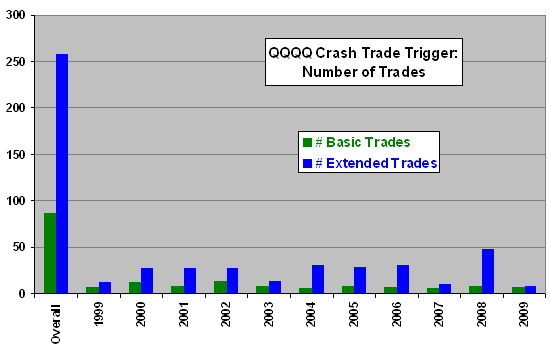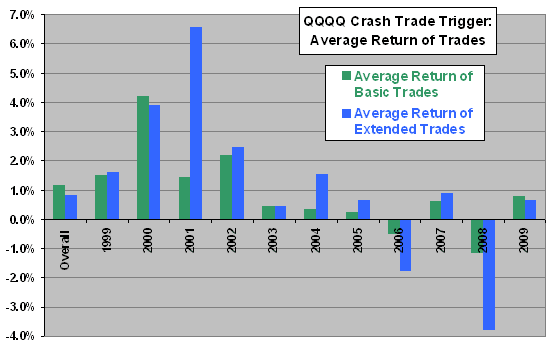In 2007, a reader inquired about the usefulness of James Altucher’s QQQQ Crash Trade Trigger. As stated by James Altucher: “The basic idea is that if the QQQQs, the volatile ETF representing the Nasdaq 100 index, make a sharp move down, then mean reversion will eventually kick in and bring the index back up. In other words, whenever people are panicking, that’s the time to get in. The move is not always a huge move but it’s been reliable.” Using QQQQ daily open, low and closing prices for 3/10/99 (the earliest available) through 8/19/09, we find that:
To test the QQQQ Crash Trade Trigger, we apply the rules and guidance as stated in the referenced article, as follows:
- Buy [at the following open] when QQQQ closes 1.5 standard deviations below the 10-day moving average of the daily low price.
- Sell [at the close] either after 20 [trading] days or on any earlier day that QQQQ closes higher than the entry price.
- “The way I would play this now is to leg into it. Take a partial position at the entry price and then average down if the trade lasts for more than one day. If the QQQQs close higher than the entry on day one then so be it. Take the profit and go on to the next trade. If the QQQQs close lower, then start to take a more full position and get a better average price than the system price.” We implement this guidance mechanically by buying at the open on each day that a trigger remains in force.
In all the analyses that follow, we assume round-trip trading friction of 0.2%. Actual trading friction would depend on QQQQ liquidity (bid-ask spread), specific broker transaction fees and account size.
The following chart summarizes the total number of basic trades (initial entries) and extended trades (initial entries plus daily “average down” trades until the initial entries close) over the entire sample period and by calendar year. The average number of basic (extended) trades per year is about eight (25). Only three of the 86 basic trades reach the 20-day limit on duration.
How profitable are the trades?

The next chart summarizes average returns for the basic and extended trades over the entire sample period and by calendar year. Over the entire sample period, the average return for the basic (extended) trades is 1.2% (0.8%). In general, the QQQQ Crash Trade Trigger is fairly profitable during 1999-2002, but not during 2003-2009.
Why might profitability have degraded starting in 2003?

The referenced article states: “I’ve been writing about the QQQQ Crash system since early 2003.” Since beginning of 2003, the average return of basic (extended) trades is 0.38% (-0.90%). The basic trades remain profitable as long as round-trip trading friction is below 0.58%. The extended trades are unprofitable even if trading friction is zero. The poor performance of the trigger since 2003 relative to its pre-2003 performance may be due to:
- Data mining bias in the pre-2003 analysis that discovered the trade trigger.
- Market adaptation to the trigger after publication.
Note that managing capital allocation to such strategies is problematic. The above analysis assumes that the trader always has cash (or credit) available to trade QQQQ Crash Trade Triggers when they unpredictably occur. The extended (average down) trading is especially problematic since the trader generally must: (1) trade in small increments, elevating trading friction as a percentage of trade size; and, (2) hold most of available capital in reserve, greatly limiting return on total capital.
In summary, the QQQQ Crash Trade Trigger has not worked very well since James Altucher began writing about it in 2003, perhaps due to data snooping bias in the pre-publication analysis.